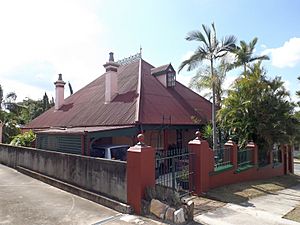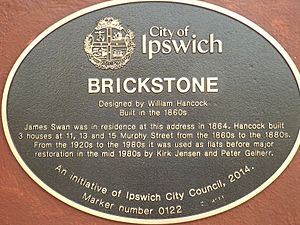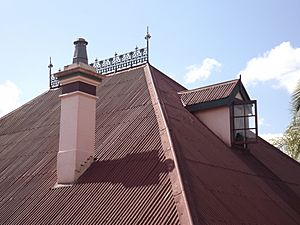Brickstone facts for kids
Quick facts for kids Brickstone |
|
|---|---|

Murphy Street view, 2015
|
|
| Location | 11 Murphy Street, Ipswich, City of Ipswich, Queensland, Australia |
| Design period | 1840s - 1860s (mid-19th century) |
| Built | c. 1864 |
| Built for | James Kirby Swan |
| Architectural style(s) | Georgian |
| Official name: Brickstone, Brixton | |
| Type | state heritage (built) |
| Designated | 21 October 1992 |
| Reference no. | 600590 |
| Significant period | 1860s (fabric) 1860s-1870s (historical) |
| Significant components | residential accommodation - main house, cellar, kitchen/kitchen house, attic |
| Builders | William Hancock |
| Lua error in Module:Location_map at line 420: attempt to index field 'wikibase' (a nil value). | |
Brickstone is a special old house at 11 Murphy Street in Ipswich, Australia. It's a "heritage-listed" building, which means it's important to history and protected. William Hancock built this house around 1864. It's also sometimes called Brixton. The house was added to the Queensland Heritage Register on 21 October 1992.
History of Brickstone
This two-storey house has an attic. It stands on land that was first marked out in 1861. In April 1861, Mr. James Kirby Swan bought a part of this land. He was a local wheelwright and owned land in town.
The house was built by a well-known local builder, William Hancock. We don't know the exact year it was built. However, James Kirby Swan was listed as living at this address in 1864. This suggests the house was built for him in the early 1860s.
William Hancock bought land next to Swan's in 1863. The Hancock family history says William built three houses in a row on Murphy Street. These were numbers 11, 13, and 15. This also points to the house at 11 Murphy Street being built in the early 1860s. Hancock himself lived at 11 Murphy Street for a short time in 1875.
William Hancock moved from England in 1856. He worked in Brisbane briefly before moving to Ipswich. He lived there until he passed away in 1892. Hancock was famous in Ipswich for building with bricks. He worked on many buildings. These included additions to Rockton Villa and Booval House. He also helped build the first railway workshop foundations.
Brickstone was built during a time when Ipswich was growing fast. The town was making money from coal mining, wool, and cotton. Ipswich was a busy trading point. It had a port on the Bremer River. The first railway in Queensland opened nearby in 1865. William Hancock helped a lot with Ipswich's early growth. Brickstone is part of his contribution.
The house has three levels. It originally had eight main rooms. It also had a separate kitchen and laundry building. In 1877, Mr Samuel Irwin bought the house. Since then, many different people have owned and lived in it. This includes William Hancock's married daughter, Elizabeth. Her unmarried daughter lived there until she died in 1956.
From the 1920s until 1982, the house was mostly used as flats. During this time, it changed quite a bit. The attic was closed off, and the stairs were removed in the 1920s. The verandah was also enclosed. The original grey slate roof was replaced with metal. The attic windows were taken out around the same time.
In 1985, Kirk Jensen and Peter Gelherr bought the house. They changed it back from flats. They redecorated the inside in a fancy Victorian style. They put in new stairs to the attic. These stairs were recycled from another building. The attic was reopened with new windows on three sides of the roof. Most of the inside decorations were added during these 1980s changes.
In 1989, Mrs Adele Rule bought the house. She lived there until 2012. Then, a local couple bought it. They still live there and take care of the home.
We don't know where the name "Brickstone" came from. But the house was known as "Brixton" before the big renovations.
What Brickstone Looks Like
Brickstone is a large brick house. It has a very steep roof. This makes it stand out on the street. The house has three levels. It is made of strong bricks with special lines in the mortar. It has a roof that slopes down on one side. There is a central triangle-shaped part (gable) over the front verandah. There are also four windows that stick out from the roof (dormer windows) for the attic.
The current dormer windows were built in the 1980s. This was when the attic was reopened after the house was flats. New steps were also added to the verandah at this time. Older photos show the verandah was reached by stairs from the corner.
The main level has four main rooms. There is a central hallway. A verandah wraps around two sides of the house. The back and part of the side verandahs were closed off. These now form rooms like bathrooms and storage areas. The main staircase was put in during the 1980s. It came from another building, possibly an old doctor's house. Most of the wooden parts, like doors and window frames, have been replaced. They were taken from other old buildings. Fancy decorations on the ceilings were also added. The iron posts and railings on the verandahs are mostly original.
The lower level has two large rooms and a cellar. The wooden parts here have also been replaced. Ceiling decorations and other fancy plasterwork were added. The attic was rebuilt in the 1980s. It has new walls and ceilings. The dormer windows were added then too.
There is a separate building behind the house. People say it used to be the original kitchen and laundry. You can get to it from the lower level terrace. A new covered parking area and walkway have been added next to the house.
Why Brickstone is Special

Brickstone was added to the Queensland Heritage Register on 21 October 1992. This means it's officially recognized as an important historical place. Here's why:
It Shows How Queensland's History Developed. Brickstone is important because it shows how Ipswich started to grow with many houses. This happened around the area called Denmark Hill. The house was built in the early 1860s. It shows how strong Ipswich became as a center for industry and trade in the late 1800s. This growth led to the neighborhoods we still see in central Ipswich today.
It Looks Beautiful and Important. Brickstone also looks very special. It adds a lot to the look of Murphy Street. Its large size on a corner block and its steep roof make Brickstone a local landmark. Everyone in the area can easily spot it.
It Connects to Important People in Queensland's History. Brickstone has a special link to the life and work of William Hancock. He was a very important local builder. He built the house and lived there for a short time. Hancock built many brick buildings. His work can be seen in other big houses in Ipswich, like Rockton Villa and Booval House.
Images for kids





